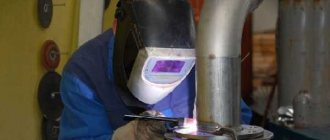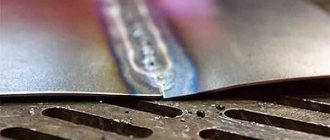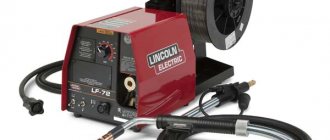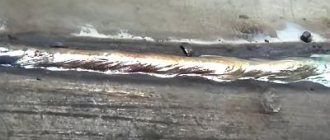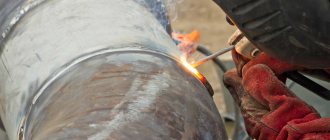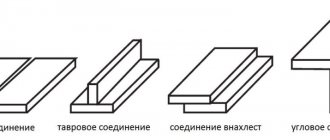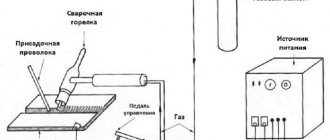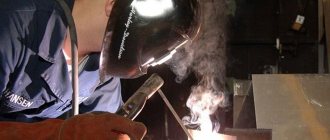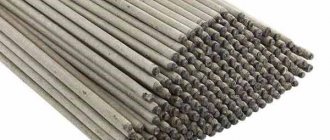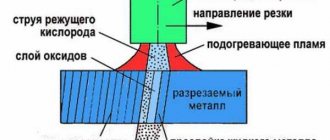Home / Electrodes
Back
Reading time: 3 min
0
1610
In his professional activity, any welder will sooner or later encounter thin sheet metal. This can be any metal sheet with a thickness of up to 2 mm.
It is found quite often, for example, profiled pipes are made from it.
Work of this type is not the most difficult of welding works, it does not require high power of the apparatus and large-diameter electrodes, however, there are nuances that must be taken into account, otherwise the weld will not be of high quality.
In this article we will talk about the intricacies of working with thin sheet metals.
- Welding Features
- Types of arc welding
- Electrodes for welding
- Preparation for welding
- Inverters
- Welding technique
- Working with galvanized steel
- Finally
Peculiarities
The rules for welding thin metal using an inverter apparatus differ significantly from those recommended for thick-walled products. First of all, the difficulties caused by the specific behavior of the metal under the influence of electrical forces are taken into account. However, the technology also has its advantages. Let's look at these nuances in more detail.
Difficulties
When welding two metal workpieces with a thickness of 2-3 mm or less using an inverter, the following series of specific difficulties arise:
- A thin metal product burns out when overheated . For this reason, the docking procedure should be carried out as quickly as possible, but without compromising quality. During prolonged processing, the workpiece, if it does not burn out, will become distorted. Therefore, the electrode must be carried out exclusively in the direction of the seam - without the slightest deviation.
- The current parameters must have a minimum value. As a result, the arc becomes short. The slightest increase in distance leads to its extinction. In some cases, it may not ignite for a long time. Under such conditions, a welding machine with an open voltage of at least 70 volts and the ability to gradually change the current strength, starting from 10 amperes, is selected.
Responsible welding of thin-walled products Source aqua-rmnt.com
- Warping due to excessive heat. The slightest increase in temperature will cause the sheet to bend. The best way to prevent this is to carefully select welding parameters and control the degree of heat. In addition, if the situation allows, then special heat-removing materials are used, carefully placed at the bottom of the seam.
- Lack of penetration on the front side and sagging on the back side. These defects are often characteristic of welding thin metal with an inverter for beginners. If all of the above disadvantages can be neutralized to one degree or another by the correct selection of parameters, conditions and tools, then these two completely depend on the skill of the master. Unwelded or missed spots are often the result of the welder’s haste; leaks, on the contrary, are due to excessive effort. In both cases, you need to adjust your technique.
Important! To obtain a high-quality weld, the connection of the edges of the workpieces must be as tight as possible - without the slightest gap. To do this, before welding, they are carefully freed from rust, cleaned and, if necessary, trimmed.
High-quality seam on tank metal Source stroychik.ru
See also: Catalog of companies that specialize in complex installation of internal engineering systems
Advantages
Inverter welding is the best, modern and affordable way to weld thin metal. If all the technology conditions are met, the seam turns out to be of very high quality, durable, airtight, durable, and invisible during subsequent finishing and coating. With its help, it is possible to weld thin-walled structures for various purposes - for example, car bodies and parts, containers, pipes. The only common drawback of inverter welding technologies is instability at negative ambient temperatures.
Galvanized welding
There is only one way to weld thin metal with a 3 mm electrode when the workpieces are coated with a layer of zinc, this is inverter welding with preliminary cleaning of the surface layer at the joint. The procedure is performed using several methods:
- Mechanical. For this purpose, grinding machines, abrasive wheels, brushes with steel bristles, and sandpaper are used.
- Heat treatment by welding. The zinc layer is burned out by a double pass of the electrode along the entire trajectory of the weld, followed by obligatory beating of the resulting slag.
Rules for maintaining the electrode when thin-walled welding Source stroy-podskazka.ru
Another feature of welding galvanized products is the need to create a double seam:
- The first pass is performed with a rutile electrode with the lowest amplitude.
- The second pass is finishing, facing. It is carried out using a main electrode with a weld width equal to 3 times the diameter of the tool.
Note! Removing galvanization by electric welding is accompanied by an increase in the temperature of the metal at the point of contact with the electrode to almost 1000°C. Under these conditions, zinc oxidizes and evaporates, creating toxic fumes in the air. Therefore, it is permissible to perform the procedure only in a well-ventilated area or outdoors.
What is an electrode and why is coating needed?
An electrode is a metal rod in a shell, which is called electrode coating. When welding, the electrode melts and mixes with the base metal. The coating, which consists of special substances, also burns. In general, they form a gas cloud during combustion, which protects the weld pool and molten metal from external exposure to oxygen.
Various materials can be used to make the electrode rod. Therefore, the first rule when choosing electrodes is that the material used to make the rod is as close as possible in composition to the metal being welded.
Electrodes are available for welding alloy, carbon, and also for welding high-alloy steels. There are also electrodes for sale for cast iron, aluminum, and for welding stainless steel. In general, the electrode material must be similar in composition to the material being welded.
Selection of equipment and tool parameters
Only the correct ratio of the operating parameters of the apparatus, the tool used and the thickness of the material itself makes it possible to qualitatively solve the question of how to weld thin metal with an electrode. Both beginners and experienced welders apply the following established patterns:
| Material layer, mm | 0,5 | 1 | 1,5 | 2 | 2,5 |
| Electrode diameter, mm | 1 | 1,6-2 | 2 | 2-2,5 | 3 |
| Current strength, ampere | 10-20 | 32-35 | 45-55 | 60-70 | 75-85 |
Selection of electrodes for welding thin metal Source ytimg.com
In this case, welding using an inverter can take place in two versions according to the characteristics of the current produced by the machine:
- Permanent.
- Variable
In the first case, the question of which electrode to weld 2 mm metal is solved by connecting the circuit using reverse polarity. This means that the “minus” is connected to the workpiece, and the “plus” is connected to the holder. This scheme leads to a shift of heat to the tool, and not to the metal part. Therefore, it is possible to avoid burnout, deformation and sagging.
The second option involves welding with a lower current value than for thick-walled sheets. In this case, the frequency must be high. Starting current indicators should be reduced by at least 20-30%. As an option, experienced welders ignite the electrode on a blank located end-to-end to the workpiece, and then immediately move on to the working seam.
Advice! A guarantee of quality, accuracy, and durability of the weld on thin-walled parts is the use of low currents. However, only an electrode 2 mm or thinner can best meet these parameters. Moreover, it must be made of an easily meltable material.
Inverter for thin metal with variable parameters Source svarkatver.rf
How to choose polarity when operating an inverter?
Polarity is the basis of a quality welded joint. Direct polarity provides a reduced heat input into the metal base with a narrow but deep melting region.
With reverse polarity, a reduced supply of thermal energy is observed in a material with a wide and shallow melting region of the base metal.
It is the polarity of the electrons that needs to be paid attention to before starting work on the inverter.
If you weld metal using direct current, you can use the positive and negative charge of the source.
But at the same time you need to know where to connect which charge.
Here it is necessary to take into account that if a positive charge is provided to the material being welded, it will become very hot.
If this charge is connected to an electrical conductor, then the electrode will become very hot and burn, which can lead to burning of the metal.
Video:
The way out of the situation is to reverse the polarity of the inverter and the optimal current indicator.
During operation of the inverter, the electrode is connected “+” to the inverter arc, and “-” to the sheet of metal.
Technique options
In all cases, without exception, welding of thin metal with an inverter should be carried out as soon as possible. The electrode is passed along a straight path only once and without stopping. Current parameters are minimal. Before starting, the surface of the parts must be prepared:
- Attention is paid to the initial geometry. If it needs to be kept unchanged, appropriate measures are taken - heating is minimized, clamps are used.
- The edges of the workpieces at the joints are cleaned of traces of corrosion, dirt, paint, etc.
- Next, the workpieces are fixed or installed in the required position - in accordance with the technology.
Upon completion of the preparatory work, when the workpieces are secured, preliminary spot welding tacks are performed - at a distance of no more than 5-10 cm from each other. This allows you to avoid many negative effects - burning, sagging, deformation.
Techniques and methods for joining thin metal sheets
In each specific case, it is important to determine which technique should be used when joining thin-walled material.
electrodes for thin-walled materials
The flanging method involves bending the edges of the sheet to the required angle and fastening it with transverse seams every 5-10 cm. Then you need to lay a continuous seam from top to bottom.
However, it is not always possible to weld a continuous seam without burning through the material. In this case, you can try to tear off the arc for just a few moments and lower the electrode back to the same place, moving it a couple of millimeters. This is done so that the metal has time to cool during arc separation. The most important rule when carrying out such actions is not to let the metal cool too much.
Butt welding of thin iron is difficult to achieve. It is better to overlap it.
When butt welding, wire can be placed between the sheets. In this case, the arc must be drawn along it. It takes on the entire thermal load, while the sheets themselves do not overheat.
Instead of wire, copper plates can be placed between the sheets. Copper has good thermal conductivity, about 7 times higher than steel. The plates are placed under the welding site, and it “takes” the heat to itself, preventing the metal from overheating.
Video description
Video on how to weld metal with a 1 mm electrode:
There are two main techniques for welding thin metal with a 2 mm electrode - these are:
- Continuously.
- Intermittently.
The first option is usually used when the edges of the workpieces overlap. Negative effects, such as burn-through, sagging and curvature, are either minimized or do not appear at all. This makes it possible to use larger parameters of current strength, electrode diameter and a lower welding speed.
The second technology is used for parts with the smallest thickness when joining butts. In this case, the characteristics of current strength and electrode diameter are used at a minimum, and the speed of welding is maximum. Welding in this case is carried out in short sections with approximately the same pitch.
Recommendation! When welding thin-walled parts butt to reduce the risk of overheating and, as a result, burning of the metal, a copper substrate or wire is placed on the back side of the seam being formed. Due to its high thermal conductivity, the material quickly removes heat and prevents burning of workpieces.
Types of thin metal joints in manual arc welding.
- Using a continuous welding arc. In this case, the electrode must be directed at medium speed. If you move the electrode too quickly, not the entire seam will be welded, but only its upper part. If you move the electrode slowly, you can burn through the metal.
- With the cessation of the arc. This method is the most popular for joining thin metal.
- Spot welding.
As with manual arc welding, and when welding metal with an inverter, thin metal must be welded very quickly to prevent it from cooling.
Recommendations for beginners
There are several simple but important recommendations on how to weld thin metal with an inverter for beginners:
- The high quality of the seam is guaranteed by careful control from all sides during welding work.
- The distance between the electrode and the workpiece (arc gap) must be equal to the electrode diameter. With a lower value, the seam will take on a convex shape; with a higher value, it will not be cooked through.
- To visually control the distance between the electrode and the metal, it is necessary to focus on the hot area at the point of contact. The appearance of a red spot indicates the melting process - necessary for the welded joint.
- For the tightest connection of sheets when overlapping welding, it is necessary to press down the parts with a weight or clamp them.
- The smaller the distance between the seams with the spot welding technique, the less the curvature.
- The best inclination of the electrode when welding is from 45 to 90 degrees.
Helpful information! If the goal is to heat as little as possible, the workpieces must be placed in a vertical position. In this case, the angle of contact of the electrode with the metal should be within 30-40 degrees. Movement occurs only from top to bottom.
Popular brands of electrodes
It is not enough to focus only on the diameter of consumables in order to choose the best option and ultimately obtain a high-quality connection. After all, each of the brands of consumables presented on the consumer market is designed to work under certain conditions or with specific metals. Therefore, even a quick acquaintance with the characteristics of the most popular brands of electrodes will be very useful for beginners.
Popular brands of electrodes include:
- MR-3S . They are universal and considered one of the most popular. Can be used with both AC and DC current. The advantages of these consumables include easy ignition of the arc both during the first and subsequent contacts with the working surface. The coating contains rutile and perfectly protects the metals being joined from oxidation and excessive slag formation.
- ANO-37 . Designed for welding workpieces from low-carbon and carbon metals. Insensitive to rust and dirt. They perfectly cover large gaps between structural elements. The packaging contains instructions with recommendations for adjusting the current strength for electrodes of different diameters. Characterized by ease of ignition of an electric arc. Provide good results even with low current. Recommended for use by beginners and amateurs.
- OK 46.00 . Recommended for use when working with carbon steel workpieces. With their help, it is easy to ignite an arc and keep it stable even on a dirty surface. They have proven themselves to be excellent in working with wide gaps between welded surfaces. They are characterized by a low threshold of sensitivity to rust and various contaminants, and slight splashing of the melt. Used for suturing in different spatial positions.
- OZS-4 . Designed for joining workpieces made of low-carbon metals. Before starting work, it is not necessary to clean the surface from rust and other contaminants. The rods do their job perfectly even if there is condensation on the surface. With their help, the electric arc is ignited easily and burns stably, regardless of the size of the electrode and the number of ignitions. The package comes with instructions that contain recommendations on current parameters when working with electrodes of different sizes. OZS-4 work perfectly in different modes and easily connect products of large and medium thickness.
- LB-52U . Distinctive features: minimal melt spatter, high productivity, stable arc burning in different conditions and under different operating modes, allow you to form a welding seam with high mechanical properties.
- ANO-4 . Designed for welding carbon metal workpieces. Work well on dirty, rusty and wet surfaces. The arc is easy to ignite and maintaining stability is easy. The rods are characterized by low sensitivity to changes in arc length. Experts note the tendency of electrodes to form internal pores. Nevertheless, the seam is strong and reliable.
Regardless of the brand, almost all electrode packages contain instructions for their use inside. If the document is not in the package, then it is present directly on it. Here the welder will find information on choosing the current strength for an inverter or other welding machine, depending on the diameter of the electrode.
Briefly about the main thing
To answer the question of how to weld thin metal with an inverter, it is necessary to take into account a number of difficulties that arise:
- Thin metal instantly burns through when overheated.
- The arc gap is small, since the current supplied by the device should be minimal.
- A long seam and thin structure leads to curvature of the part.
- Unwelded areas and sagging on the reverse side of the joint often accompany the work of an inexperienced welder.
If all the nuances and techniques are followed, the inverter allows you to obtain a strong, high-quality, durable and invisible seam. However, this will require careful selection of equipment operating parameters and electrode diameter in accordance with the specific thickness of the material. There are two main techniques - continuous for lap welding and discontinuous for butt welding. To successfully carry out welding work, novice welders should take into account the recommendations of specialists.
Ratings 0
Galvanized connection
Galvanization, that is, galvanized steel, is ordinary steel, most often in sheets, only coated with zinc. When working with galvanizing, many craftsmen encounter difficulties due to which they are unable to form a high-quality seam.
The thickness of the electrode coating with zinc can be different. If you need to weld it, all the zinc must be removed from the edges. This can be done in the following ways:
- Remove mechanically using a grinder, grinder, sandpaper or wire brush
- Burn it out by welding. However, in the process, zinc evaporates, the vapors of which are poisonous. Therefore, such work should be carried out outdoors or indoors where there is a properly functioning hood.
Thus, joining thin plates of metal products requires a specialist to have certain knowledge and practice. It is very difficult to carry out such a process correctly the first time. You can make the right choice of electrodes for welding using the tables above. It is important to remember that the diameter of the electrode, depending on the thickness of the metal being welded, should be selected wisely. Thus, you need to understand what conditions are chosen from and what indicators need to be followed in order to connect thin-walled metal efficiently.
Electrode selection criteria
First of all, it should be borne in mind that electrodes can be of consumable and non-consumable type. The first ones are made of a metal rod, onto the surface of which a special coating is applied, which helps protect the welding zone and increases the stability of the arc. They are used to perform manual arc welding. Products of the second category - non-consumable - are used to perform welding work in a shielding gas (argon), their varieties and features of use will be discussed in a separate article.
When choosing electrodes for welding using an inverter, you should take into account that the material of the parts being joined will also affect the quality characteristics of the seam being formed. Accordingly, in order to weld different materials, different types of welding electrodes are used. So, for example:
- to connect products made from low-carbon and low-alloy steel grades, carbon electrodes are chosen;
- to connect products made of alloy steel, electrodes of the corresponding brands are used: OZS-4, MR-3 (GOST 9466-75), MR-3, ANO-21, UONI 13/45 (GOST 9467-75);
- if it is necessary to carry out welding work with surfacing or other types of steel, then choose electrodes with a core made of high-alloy metal - TsL-11 (GOST 9466-75);
- in order to cook cast iron, it is also necessary to select electrodes of the appropriate brand - OZCH-2 (GOST 9466-75).
General view of MP-3 electrodes
To date, the following rating of electrodes used for welding using an inverter has been formed.
- ANO. Welding electrodes of this brand are highly flammable and do not require additional calcination. Both novice welders and professionals can work with them equally successfully.
- MP-3 is a universal type; they can even be used to connect uncleaned surfaces.
- MR-3S. Electrodes of this brand should be chosen if increased demands are placed on the characteristics of the seam.
- UONI 13/55 is used for installation of critical structures that require high quality welds. It will be difficult for a novice welder to work with them: their use requires certain experience and high qualifications.
Electrodes UONI 13/55
Types of coatings
For novice welders, it would be a good idea to learn to distinguish electrode brands visually, based on the appearance of the coating. After all, situations may occur when consumables are provided without packaging.
There are 4 main types of electrode coatings:
- Basic (indicated by the letter “B”) . A common type of coating containing magnesium and calcium carbonates. Characterized by low levels of hydrogen. As a result of the use of electrodes, a high-quality seam with high plastic and strength characteristics is obtained. The connection is characterized by high quality and high impact strength. Popular brands of products are produced with this coating - UONI 13/45, UONI 13/55, UONII 13/55. A characteristic disadvantage of the rods is a large amount of slag.
- Rutile (indicated by the letter “R”) . The coating is based on titanium dioxide, which is better known as rutile. During operation, the coating ensures easy ignition of the arc, both the first and all subsequent ones. The arc is characterized by combustion stability throughout the entire period of use. A minimum amount of spatter is generated and the slag is easily separated. The voltage on the welding machine is set depending on the diameter of the consumable, and as for the current strength, the manufacturer provides detailed instructions for adjustment.
- Sour (indicated by the letter “A”) . The coating contains manganese, iron, silicon and other elements. Electrodes with acid coating are suitable for working on coatings with scale and rust. The likelihood of air channels forming in the seams is minimal. But the appearance of hot cracks is not excluded.
- Cellulose (indicated by the letter “C”) . the coating consists of a large number of components, including cellulose, ferroalloys, organic resins and other inclusions. Excellent consumables for making vertical welds. Thanks to the dense cloud of protective gases, the level of slag formation is reduced. However, their use is accompanied by strong splashing of the melt.
Before performing welding work, you should carefully study the properties of each group of electrodes in order to select the best option. In order for the connection to have a large margin of strength and serve without fail for many years, it is necessary to correctly calculate the optimal diameter of the electrode and the current strength. Professionals, relying on their experience, do all this almost instantly and, most importantly, correctly. But novice welders make mistakes quite often. Auxiliary materials and working to improve your level will help you avoid unpleasant miscalculations.
